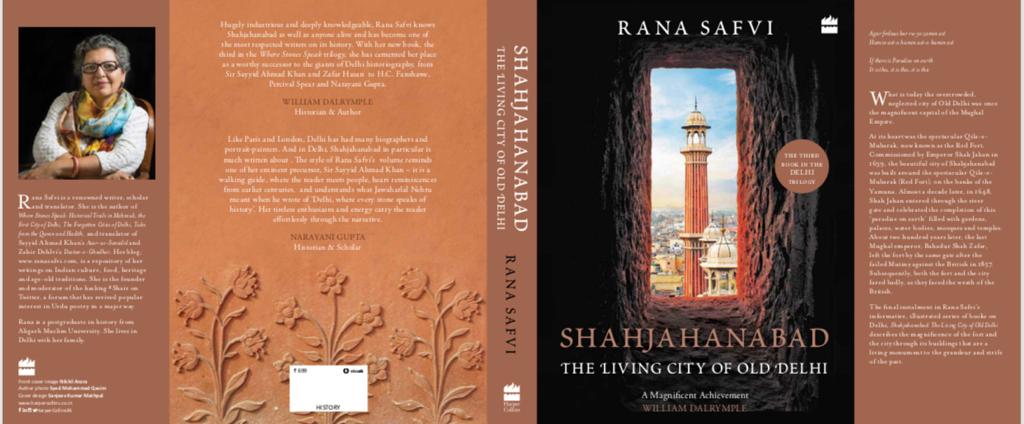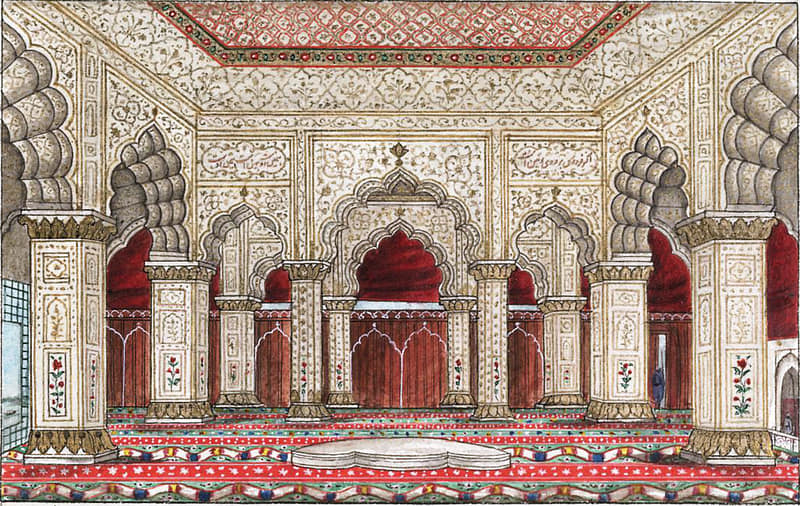
Book review, Shahjahanabad, The Living City of Old Delhi authored by Rana Safvi & published by Harper Collins (2019)
There is a reason why it is called the ‘living city’ of Old Delhi, by the author Rana Safvi, in her book, Shahjahanabad, which is the third book in the “Where Stone Speak” Trilogy, a series published by Harper Collins India. Unlike other cities like Tughlaqabad, Old Delhi, which was actually relatively new in the timeline of the cities of Delhi, is a place where it’s milieu is astir with not just it’s monuments that includes mosques, mandirs and mahals, but there are people living within the environs of this very city, relaying the legacy of times gone by. There are the gullies and koochas (lanes and bylanes) that haven’t been able to shake off the time-dust that has settled over them. There is the Qila e Mubarak and Jama Masjid, that peg down the medieval character of the place. And then there is the Mughlai cuisine which is still as delectable as the centuries it reminds us of.

Rana Safvi plays the role of an omniscient guide, a companion spirit if you may, as she opens up a portal to a land that is now mere memory. We see a Lal Qila (red fort) rising up in all its splendour, from the point where it was being laid down brick by brick. It is impossible to ignore the vision and ambition of a man who set his throne a little lower than the mimbar (pulpit) of the grand mosque (The Jama Masjid). In his vision existed gardens of redolent vigour, and streams that made their way to every part of the new paradise – the Nahr e Bahisht. We also find ourselves witness to grandiose ideas like the Orpheus panel, a work of Italian craftsmanship, that had animals and birds, forging a connection with the King Solomon of lore. But as we see the breadth of detail, we also see the length of an outline that goes beyond the King’s residence.

Between and around the Fort and the Mosque, a city was laid down. The city, with walls surrounding it from all sides, had 13 gateways and 14 wicket gates. Within its confines, were ancient remnants like the Nigambodh Ghat and Neeli Chhatri, sites that go back to ancient Indraprastha itself. There are multitudes of mosques and dargahs strewn all over the place. There are bazaars founded in the manner of Iranian and Arab souks. Ultimately, we have the grand mosque, the Jama masjid, built on a hill, looking over the entire city. It was then, as it is now, a symbol of faith and grandeur. Structures like the Matia mahal and Turkman gate acted as foci for the development of more bazaars and residences around them. We also see many temples, dargahs and mosques (new and old) shaping up the environs. But that’s not it. The real delight of the place are the havelis. Huge residences like the Rang mahal and the Haksar Haveli, are only a few of many. Amidst all this, how can Chandni Chowk be ignored. It was built by none other than the Princess Jahanara herself. She was the eldest daughter of Shahjahan, and a sister to both Dara Shikoh and Aurangzeb. After the war of succession, she immersed herself in realising her more architectural capacities. She build the Chowk, the Begum ka Serai and Begum ka Bagh. Chandni Chowk was to be a market square and it carries on in that capacity to this day. Rana Safvi has been so meticulous about detail, she has even mentioned the roads and lanes with their respective names, along with the people who resided there. So, for instance, we have the area Ballimaran, which not only housed the Nawabs of Loharu and Hakim Ajmal Khan, but has a small by lane, Gali Qasim Jaan, which is famous for Ghalib ki haveli. There is Dharmpura which is a nest for Jain mandirs like the Bada and Chota Jain Mandirs. Besides these, there are many Koochas and Katras, which have their own brickwork of fame. Havelis and Mahals with famous associations can be seen all over these places. One of these is Sir Syed Ahmed Khan’s haveli, found near Faiz Bazar. The author relates quite a story about this one, which would better be left for the reader to discover.
As we move out of the walled city, and into the 19th century, there are British monuments that aren’t merely distant silhouettes anymore. The St. James church was built by Col. James Skinner and consecrated in 1836. It served as the principal church till the Viceroy church was built. Then there was the Delhi College, which had illustrious alumni like Sir Syed himself. The Kashmiri darwaza, from which the British exited or entered Shahjahanabad, later became a sad memory during 1857, when Bahadur Shah Zafar’s sons’ heads were hung on it.
A salient mention of the many gardens like the Qudsia Bagh and Roshanara Bagh (built by younger sister of Jahanara), cannot be dispensed with. They are testimonies to the Mughal women’s superior esthetic sense. As we see move in time, towards 1857 and beyond, the stage is set for the coming deterioration. The ridge of 1857 fame, and the plight that befell Shahjahanabad and its people, take the book to its apogee. Although much has been written about the great revolt, the author revisits the places and events that demolished Shahjahanabad as a Mughal bastion. The Zafars and Ghalibs could only be a witness to a dying day. But nearly 150 years later, Shahjahanabad lives on. In it’s festivities, and its food. In it’s people and their culture. Although the partition in 1947, wreaked havoc on the city of Delhi, and many left their homes for newer abodes, there is still an uninterrupted character to Old Delhi. One that has continued ever since Shah Jahan placed the foundation of the Lal Qila. Old Delhi is a living city, because these stones, this heritage, is quite unlike the ruins that can only be seen and heard. These stones, abuzz with life around them, can speak.
It was my honour to host Rana Safvi Sahiba on the forum of Tawarikh Khwani. Here is a link for that engaging conversation.
Aamir Khan is currently doing his doctorate in History. He is also a passionate lover of Urdu Poetry. He runs a forum "urdu.daan" on Instagram, Anchor & You Tube to share his own poetries & recitations of prominent Urdu poets.

